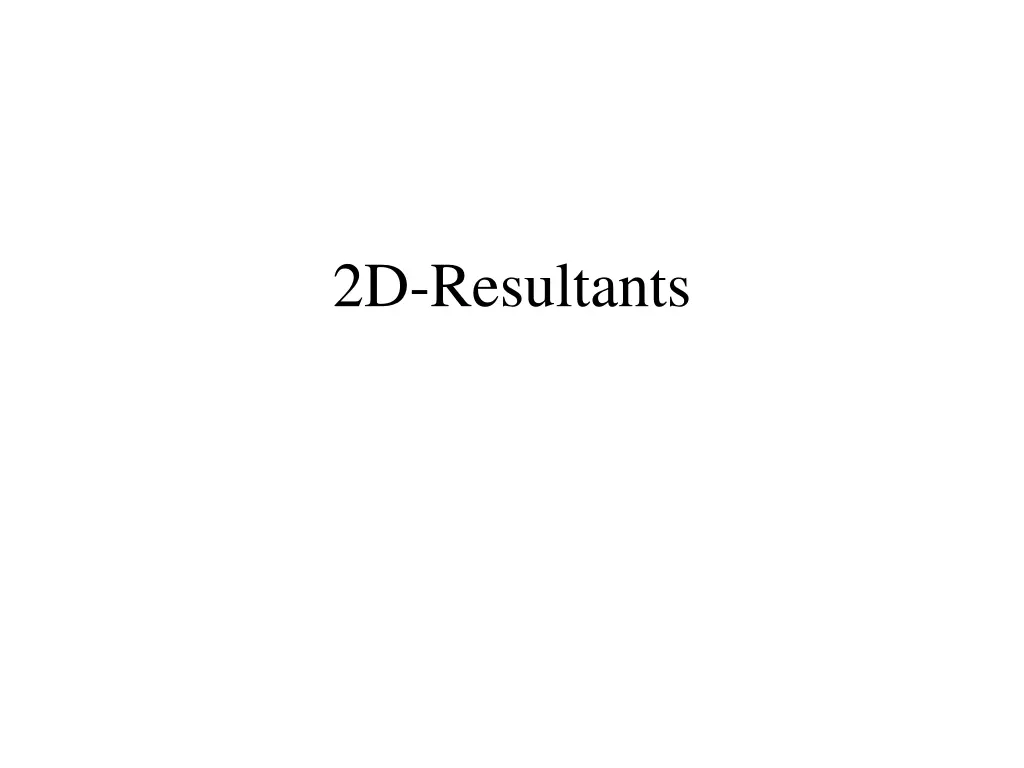
Understanding 2D Resultants and Force Systems
Learn about 2D resultants, force combinations, calculation methods, and principles applied in mechanics. Understand how to determine resultant forces and moments in loaded systems.
Uploaded on | 2 Views
Download Presentation

Please find below an Image/Link to download the presentation.
The content on the website is provided AS IS for your information and personal use only. It may not be sold, licensed, or shared on other websites without obtaining consent from the author. If you encounter any issues during the download, it is possible that the publisher has removed the file from their server.
You are allowed to download the files provided on this website for personal or commercial use, subject to the condition that they are used lawfully. All files are the property of their respective owners.
The content on the website is provided AS IS for your information and personal use only. It may not be sold, licensed, or shared on other websites without obtaining consent from the author.
E N D
Presentation Transcript
Resultants The resultant of a system of forces is the simplest force combination which can replace the original forces without altering the external effects of the system on the rigid body to which the forces are applied. 2 F 2 F 3 F 1 F R 3 F 1 F
Resultant using force polygon The resultant force R is obtained in magnitude and direction by adding the forces head-to-tail in any sequence i.e. forming the force polygon. 2 F y 2 F 3 F 1 F R 3 F x 1 F
Resultant Calculation For any system of coplanar forces resultant R can be calculated using: : In Vector = 1 form + 2 + = .......... R F F F F F 3 n Scalar : In form ( ) R to ( ) 2 2 = = = + R F R F R R x x y y x y Direction of resultant the with reference - axis. x R R y y = = 1 tan tan R R x x
Algebraic Method We can use algebra to obtain the resultant force and its line of action as follows: 1. Choose a convenient reference point and move all forces to that point (b). M1, M2, and M3 are the couples resulting from the transfer of forces F1, F2, and F3 from their respective original lines of action to lines of action through point O. 2. Add all forces at O to form the resultant force R (c), and resultant couple MO (c). 3. Find the line of action of R by requiring R to have a moment of MO about point O (d). Note that (Fd) in (a) is equal to Rd (d).
Principle of Moments The moment of the resultant force about any point O equals the sum of the moments of the original forces of the system about the same point. 2 F O 3 F 1 F = = Moment of resultant the force about R O M Rd o = = Sum of moments the of original the forces Rd about the Fd same point ( ) M Fd = According principle to of moments : ( )
Problem For the loaded system shown in the figure: 1. Replace the three forces and two couples by a single force R and moment M about point O. 2. Determine the direction of R. 3. Sketch the resultant force R that represents the force-couple system alone and find its intersection with the x- and y-axes. 100 N y 20 N 25 mm 25 mm 50 mm 600 10 mm 20 mm 110 N 10 mm x O 5 Nm 30 mm A 2 Nm 20 mm
1- + = = = o 110 20 cos 60 100 N R F x x 100 N y 20 N + 25 mm 25 mm 50 mm = = = o 100 20 sin 60 117 3 . N R F 600 y y 10 mm 20 mm 110 N 10 mm = + = + 117 = 2 x 2 y 2 2 100 ( ) ( ) 3 . 154 1 . N R R R x O 5 Nm 30 mm A 20 25 2 Nm + = 110 + ( ) 100 CCW M O 20 mm 1000 1000 50 30 + + = o o ( 20 sin 60 ) ( 20 cos 60 ) 2 5 . 2 734 N.m (CCW) 1000 1000 R 117 3 . 2- y = = = 1 1 0 tan tan 49 6 . 100 R x
y 3- . 2 734 M = = = = = 0177 . 0 m 17 7 . mm M Rd d O 154.1 N O 154 1 . R 49.60 x O 2.734 Nm . 2 734 M = = = . 0 = intercept, 0233 m 23 3 . mm x x O 117 3 . R y M . 2 734 23.3 mm = = = 0273 . 0 = intercept, m 27 3 . mm y y O y 100 R x 154.1 N x 49.60 O 27.3 mm 17.7 mm






















